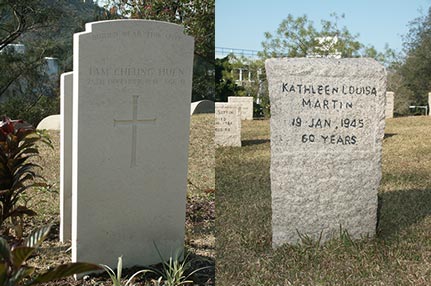Point 1 — Central Square The sculpture "Mother and Child"
The Sculpture symbolizes the concept of "One Country: Two Systems". This steel monument was erected in 1997 to commemorate the transfer of sovereignty of Hong Kong from the United Kingdom to the People's Republic of China on 1st July, 1997. It was unveiled by the Secretary of Justice, Miss Elsie Leung Oi See on 28th June, 1997.
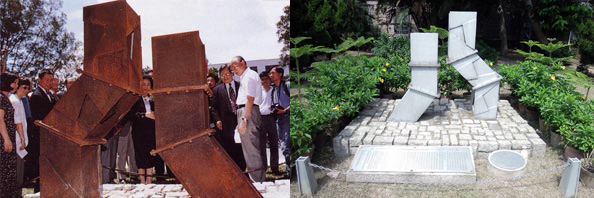
The reunification took place 48 years after the founding of the People's Republic of China in 1949. This is symbolized by the 48 steel side panels on the right (mother) pillar.
The 12 steel side panels on the left (child) pillar symbolize 12 years of transition following the official ratification of the Sino-British Joint Declaration in 1985.
Treasures collected from teachers and students are contained in the time capsule buried under the sculpture.
Point 2 — The School House and the Main Hall
The Main Building was officially opened in 1930 by Mr. W. T. Southorn, the acting Governor. It consisted of the School House and School Hall. This H-shaped building was chiefly based on the western colonial style in England and Europe at that time. It is a two-storey building with columns and arches. However, the roof is in Chinese style to suit the sub-tropical climatic conditions of Hong Kong.
The Main Building housed the school hall in the centre. The two wings, which have two storeys, were called the School House. To commemorate the efforts made by our First and Third wardens, Archdeacon Barnett and the Rev. W.H. Hewitt, the two wings were named Barnett House and Hewitt House. On its ground floor were some classrooms and on the second floor were the students' quarters. The Tower of the Main Building was named after Mr. Mok Kon Sang, a student’s parent, for his generous donation.

Around 15th December, 1941, the School House was turned into an emergency military hospital by the Hong Kong Government shortly before the Japanese invasion.
Two expatriate staff members, Mr. John Gaunt and Mr. Arthur Job, had joined the Hong Kong Volunteer Defence Corps as war approached. Mr. Arthur Job was killed on approximately 19th December during the fighting on the Island and was probably buried somewhere on Mt. Parker. Mr. John Gaunt was taken prisoner and died at Shamshuipo Prisoner of War Camp on 4th January, 1944. He was buried in Stanley Military Cemetery.
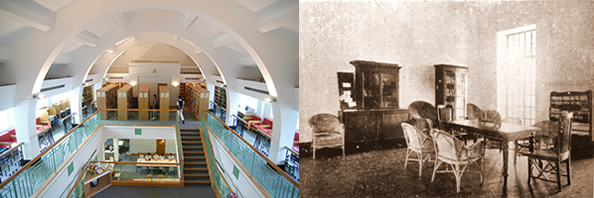
The Japanese broke into the College early on Christmas Day, 1941. The entry of the Japanese into the College initiated the "St. Stephen's College Massacre". The troops were out of control and acted with madness and cruelty. About 150-200 troops broke into the hospital (School House). The troops bayoneted and killed 56 British and Canadian soldiers still wounded in their beds, as well as some medical and College staff. Among the victims, one of them was Mr. Tam Cheung Huen, the Head of Chinese Studies. He chose to remain and die in defense of "his boys". His body was buried by school servants in the village. After the war, Canon Martin exhumed his remains and he had him re-buried in Stanley Military Cemetery.
During the Japanese occupation from 1941 to 1945, the College was turned into an Internment Camp. The Preparatory School was used for internees for a short time but then became a guard barracks. About one thousand internees were housed in St. Stephen's College. The Japanese authorities allowed the internees to more or less organize and administer the camp themselves.
In the camp, the school hall was the only large space in which people were not living and thus it played an important part in the lives of many of the internees. St. Stephen's school hall was used to provide education to students from both the junior and senior schools. Religious services and various forms of entertainment, such as film shows, drama and concerts took place in the hall, too.
Point 3 — Special Room Block
To further the College's growing facilities, the Special Room Block was built. The whole block was a Complex comprising of one multi-purpose gymnasium hall and special rooms such as an acoustically finished audio-visual centre, science laboratories and computer rooms.
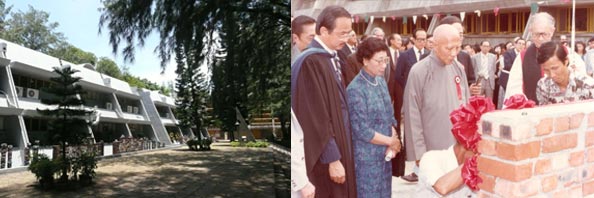
The opening ceremony was held on 14th November, 1980, and officiated by four generous donors who made this building possible: namely, Sir Shiu-kin Tang, Mr. Ho Tim, Mr. Li Ka-shing, and Sir Yue-kong Pao.
Dr. Tao Ho, the architect of the Special Room Block won the Certificate of Merit of HKIA Annual Awards in 1982 for his design of the Complex.
The bell standing in the plaza of the complex is one of the symbols of the College. The bell was originally donated in September 1930 by the great granddaughter of the first Chinese Protestant Minister, Mr. Liang Fa, to glorify and honour God. After the Second World War, the bell was rediscovered by the Royal Navy and given to St. John's Cathedral. Recognizing that the bell represented significant history, the Cathedral purportedly donated it to the College in 1946.
Point 4 — Martin Hostel
Martin Hostel was built in 1929. It has been used as a boys' or girls' hostel at different times in the College's history. Previously known as the "Hostel" and was renamed Martin Hostel in the 1980s in recognition of the contributions of Rev. Canon E.W.L. Martin who was the Principal and Warden of the College from 1928 to 1953. Most of the floor's original wooden planks are still kept in good condition.
To many students, they cherish the memory of their boarding life. When the founders established our College in 1903, they deliberately followed the traditions of the English Public School for the elite and even extended the admission to overseas students, especially those from Asia. Students were taught to be self-reliant, courageous and collaborative through boarding. Like most British boarding schools of the time, boarding life at St. Stephen's was hard-going. The boys were expected to undergo a Spartan-style of living. In winter, the boys were only allowed hot baths twice a week. They were encouraged to take part in a variety of sports. Students benefited from this tough training though, learning self-discipline and perseverance.
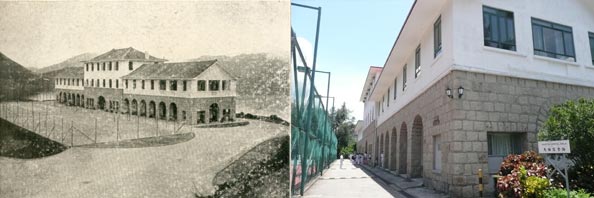
Martin Hostel is of mixed European architectural design. It is a building three storeys in height, with arches and granite blocks. The archways and columns resemble those of the Parthenon in Greece. It has a facade supported by Greek-styled granite columns, and interestingly, merges Western and Chinese architectural designs. For instance, a Western veranda employs a Chinese-styled roof to adapt to the humid sub-tropical climatic conditions of Hong Kong. The roof disperses rain easily and prevents accumulation of rain water. It also protects the building from summer heat.
Point 5 — The Chapel
The Chapel was opened by Bishop R.O. Hall on 4th March, 1950. It was built on the highest point as a memorial to all those who suffered and died in the College during the Japanese Occupation. The beautiful memorial stained-glass window over the West door, donated by Mr. and Mrs. Algy Cluff, was installed in October 1995.It depicts not only the suffering in the internment camp, but also the faith, hope and love which sustained so many throughout those years.
In the Chapel, there is a wall plaque which came from St Barbara's, a chapel in Stanley Fort. It commemorates the soldiers of the Royal Artillery who died during the war and the victims of the sinking of the Lisbon Maru in 1942.
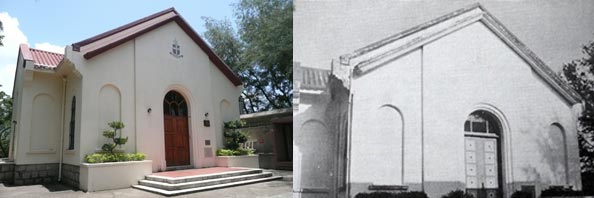
On 27th September, 1942 the Lisbon Maru left Hong Kong for Shanghai with 1816 prisoners of War to labour camps in Japan. She was torpedoed on 1st October by USS Grouper, near Tung Fusham Island. The Japanese gave no indication that there were prisoners of war in the ship, and the American submarine captain thought he was attacking a ship carrying Japanese troops. Altogether more than 800 Allied prisoners of war died in the sinking of the Lisbon Maru.
Point 6 — Centenary Building and Centenary Garden
The Centenary Building, which houses rooms such as the language laboratory and student activity room, was built under the Government's School Improvement Programme (SIP) to provide enhanced and interactive learning facilities for students.
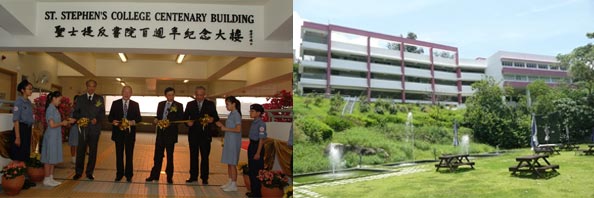
Situated under the Centenary Building is the Centenary Garden designed by Mr. Tsang Fai, an old boy of the College. The garden was partially donated by the College's Alumni Association.
The building and garden were named in commemoration of the 100th anniversary of the founding of the College and was officially opened on 10th November, 2006 by Mr. Cheng Hoi Chuen, the Chairman of the Hong Kong and Shanghai Banking Corporation.
Point 7 — Tang Shiu Kin Sports Field (The Big Field)
The Big Field was reclaimed from a malaria infested marshland in the 1920s.
During the Japanese Occupation, the sports field was turned into a vegetable garden to provide much-needed food for the internees.
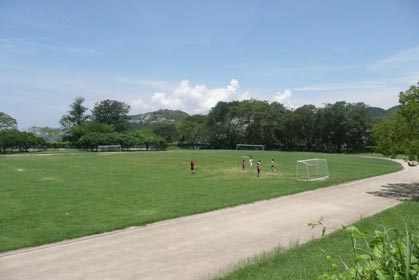
The Big Field, renamed as the Tang Shiu Kin Sports Field, was re-turfed in 1975 with the generous donations of Sir Shiu-kin Tang. It is now used for athletics and football practice.
Point 8 — Stanley Military Cemetery
The cemetery was established in the early colonial period for deceased soldiers of the British garrison stationed in Hong Kong and their families. This is also the burial place of the victims of World War II, including members of the Hong Kong Volunteer Defence Corps and British Army Aid Group. There are 598 WWII burials (including non-British Allied soldiers and 2 from Hong Kong Police Force) in the cemetery. 175 of them are unidentified. 96 of them are civilians, including 4 children. The graves of College staff, Mr. Tam Cheung Huen, Mr. John Gaunt and Mrs. Kathleen Louisa Martin, who died during the Second World War, can also be found here.
